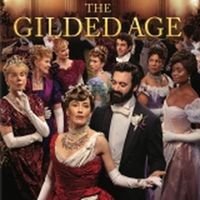On a balmy Sunday night, August 10, 2025, the grand lawns of The Elms in Newport, Rhode Island, sparkled with anticipation. Thousands gathered beneath the imposing façade of the famed Gilded Age mansion, as the Preservation Society of Newport County (PSNC) rolled out the red carpet for a very special event: a public screening of HBO’s “The Gilded Age” Season 3 finale. With a giant screen soaring at least twelve feet tall, the spectacle was a fitting tribute to the opulence and drama that have become the show’s hallmark—and to Newport itself, a city that has become as much a star of the series as any member of its distinguished cast.
For local fans, the occasion was more than just a chance to watch the season’s final twists and turns with fellow devotees. It was a celebration of the city’s starring role in the show’s lush, period-perfect storytelling. As Trudy Coxe, CEO of the PSNC, reminded the crowd, Newport’s mansions—including The Breakers, Marble House, Chateau sur-Mer, Rosecliff, Hunter House, Kingscote, and The Elms—have played host to countless scenes across three acclaimed seasons. “It’s remarkable to see these historic homes come alive on screen and to welcome the world into our city’s history,” Coxe said, drawing cheers from the crowd.
The evening’s festivities followed another highlight for Newport: just days earlier, on August 7, Christine Baranski—who portrays the formidable Agnes van Rhijn—made an elegant appearance in town, further cementing Newport’s place as a hub for both history and Hollywood.
Steven Feinberg, Executive Director of the Rhode Island Film and Television Office, took a moment to reflect on how the city’s unique character helped lure HBO’s production to Rhode Island. “I told HBO that Newport has more Gilded Age mansions per capita than anywhere else,” Feinberg recounted, underscoring the city’s appeal as a living backdrop for stories of ambition, rivalry, and social change.
HBO’s Sally Harvey also addressed the audience, sharing her excitement at seeing so many fans gathered together: “It’s really incredible to see you all here. We never get to see the viewers of the show, we never get to watch it with an audience, so it’s spectacular to be here.” Her next words brought the crowd to its feet: “We will be back next year filming in Newport. HBO loves Newport, The Gilded Age loves Newport.”
But the evening’s biggest surprise came from across the Atlantic. Series creator Julian Fellowes, Baron Fellowes of West Stafford, appeared by video with a heartfelt message for Rhode Island and its residents. “As you know, our series shows the lives of the people who made up this great state and their extraordinary homes. While filming in 2024, we created over 2,200 jobs for local cast, crew and extras during our time in Newport,” he said. Fellowes also highlighted the production’s contributions to the Boys & Girls Clubs of Newport County, including site visits and food donations, and offered thanks to the many local businesses that supported the series. “I would like to thank you, Rhode Island. And enjoy Season 3 of The Gilded Age.”
The screening itself was a dramatic affair, with the finale serving up the show’s signature blend of high society intrigue and personal heartbreak. The episode opened with the tense scene of Dr. Kirkland saving George Russell, only for George to leave Bertha—at least for now. Just before he could learn the happy news about Gladys’s pregnancy! Fans gasped and cheered as Peggy delivered a stunning proposal, Agnes delivered her trademark biting lines, and the Newport setting drew delighted reactions every time it was mentioned. The balls glittered, Mrs. Astor made a grand entrance, and the cast—especially Phylicia Rashad and Audra McDonald—delivered powerhouse performances that left the audience buzzing.
For those eager to revisit the drama (or catch up from the start), “The Gilded Age: The Complete Third Season” is now available for digital purchase on Amazon Prime Video, Apple TV, and Google Play. A collection spanning all three seasons is also available digitally on Apple TV and Google Play, with a DVD release of Season 3 scheduled for October 21, 2025. Season 3 includes eight episodes plus previously released bonus content, with a total running time of eight hours and a TV-MA rating. The ensemble cast features Carrie Coon, Christine Baranski, Cynthia Nixon, Morgan Spector, Denée Benton, and many more, under the creative direction of Julian Fellowes and a team of executive producers including Gareth Neame, David Crockett, and Bob Greenblatt. The show is a co-production between HBO and Universal Television.
Critical acclaim for the latest season has been effusive. Variety and Entertainment Weekly both hailed Season 3 as “the best yet,” while Vulture called it a “must-watch.” In its two eligible seasons, “The Gilded Age” has garnered seven Emmy nominations and a Screen Actors Guild Award nomination for Outstanding Performance by an Ensemble in a Drama Series. The show’s renewal for a fourth season was met with excitement by fans and industry insiders alike, with production set to return to Newport in 2026 and a potential release date as early as late 2026 or more likely in early-to-mid 2027. The previous three seasons have each taken about 1.5 to 2 years between them, so patience will be a virtue for eager viewers.
Beyond the glitz and glamour, “The Gilded Age” Season 3 has also contributed to a broader cultural conversation about class, race, and representation in America. This summer, Ralph Lauren released a collection inspired by the Black legacy of Oak Bluffs, a historic enclave on Martha’s Vineyard, featuring collegiate sweatshirts, patchwork jackets, and coastal-inspired attire. The collection, released in July 2025, was part of an ongoing partnership with historically Black colleges Morehouse and Spelman to design clothing that celebrates heritage and offers an “inspirational and aspirational” vision of American life.
As reported by The New York Times, the season’s portrayal of two fictional Black families—the newly wealthy Scotts from Brooklyn and the well-established Kirklands from New England—brought to light the social and economic divisions among Black Americans that have existed since the 19th century. These storylines, along with the Ralph Lauren Oak Bluffs collection and the Metropolitan Museum of Art’s “Superfine: Tailoring Black Style” exhibition, sparked conversations about elitism, exclusion, and the politics of respectability within the Black community. Fashion historian Jonathan Square noted, “When you see something so beautifully styled and, like, with radiant models and such a departure from the typical depictions of African Americans, I mean, I can’t help but be sort of moved and stirred. At the same time, I do have to recognize that it’s shot through with elitism and colorism and it doesn’t reflect the experience of most Black folks then and now.”
Costume designer Kasia Walicka-Maimone explained that the subtle differences in attire between the Kirklands and Scotts reflect the nuances of class and colorism, with Mrs. Kirkland’s expansive wardrobe signaling affluence, while Mrs. Scott’s convertible dress is a nod to the resourceful fashion strategies of the era. Historian and executive producer Erica Armstrong Dunbar expressed her joy at seeing stories that go beyond the “typical narrative,” allowing viewers to consider the varied lives of Black Americans in the Gilded Age. “One of the things that gives me great joy about this show is that we get to think about lives outside of the kind of typical narrative that we see or read about,” she said.
As Newport basks in the afterglow of another triumphant season, the city’s streets and mansions are already preparing for the next round of lights, cameras, and action. For residents and fans alike, “The Gilded Age” has become more than a television show—it’s a living, breathing part of the city’s cultural fabric, one that celebrates its past while sparking new conversations about the present.

